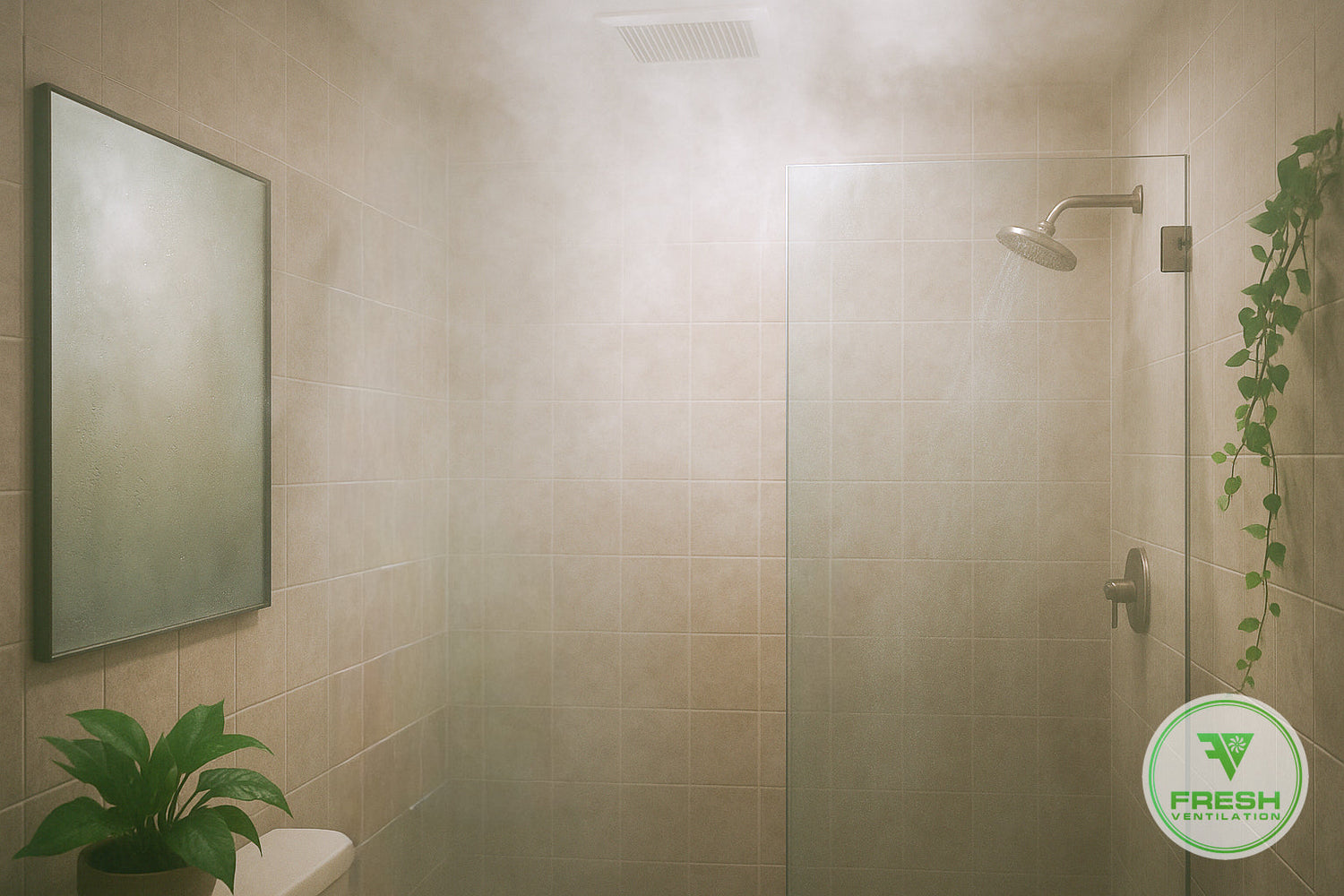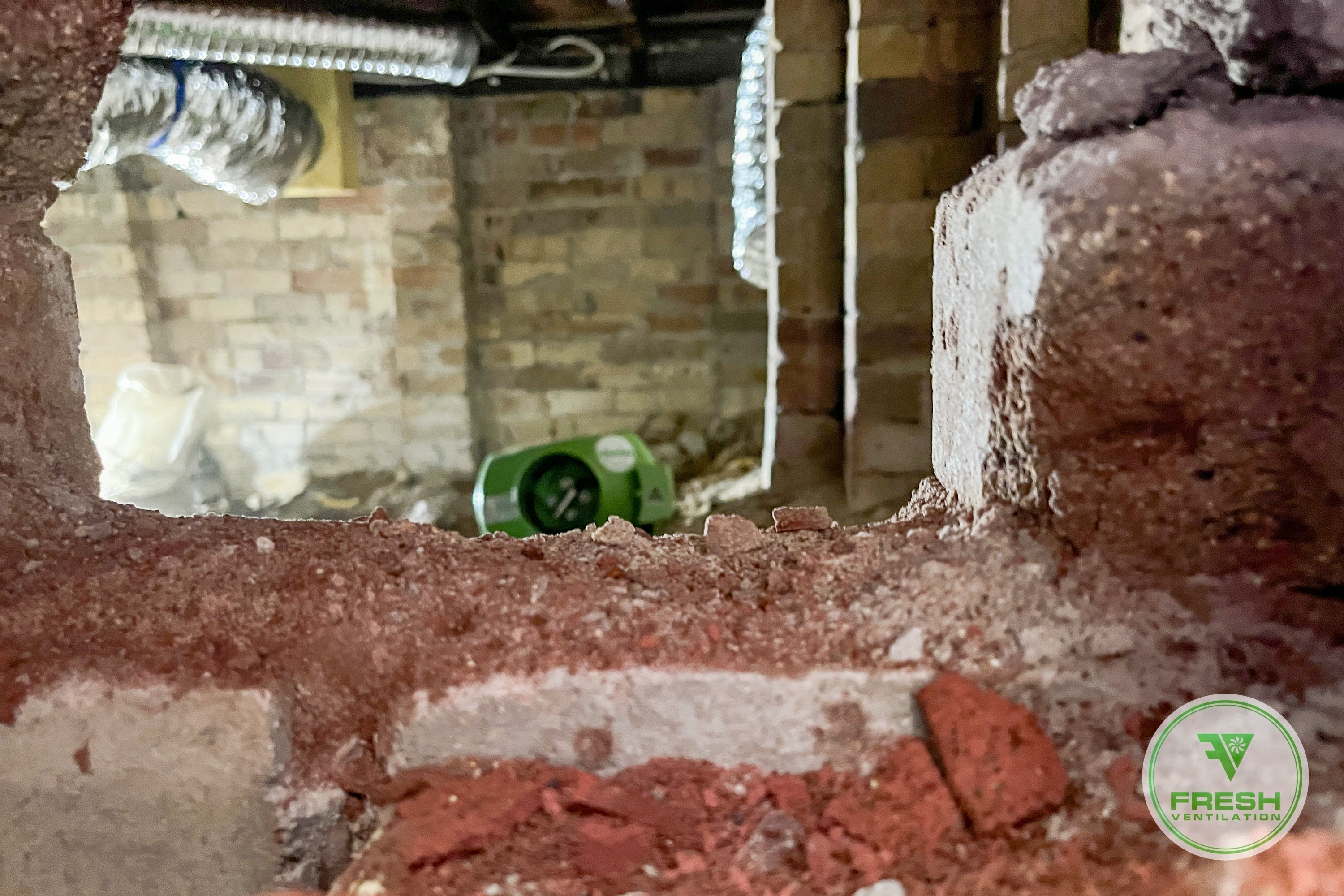Why Cold Bathrooms and Walk-In Showers Cause Excess Steam Build-Up — and How to Fix It
Managing steam and moisture in bathrooms is essential to prevent fogged mirrors, dripping ceilings, and mould growth. The amount of steam build-up depends heavily on temperature and shower design. Cold bathrooms and open walk-in showers are the main culprits — both create conditions where steam forms quickly and spreads throughout the room. Understanding why this happens will help you choose the right exhaust fan and placement to keep your bathroom clear and dry.
How Cold Bathrooms Create More Steam
Cold bathrooms are naturally more prone to steam and condensation. When warm, humid air from your shower hits cold surfaces (walls, mirrors, tiles), it cools rapidly and releases moisture — creating visible steam clouds and droplets.
- Choose a stronger exhaust fan with a higher airflow rate (m³/h).
- Run the fan before, during, and after your shower to stabilise humidity.
- Keep the bathroom slightly warm (e.g., underfloor or panel heating) to reduce the temperature difference.
Quick Tip: The colder the room and surfaces, the faster steam condenses. A higher-capacity fan helps keep up with rapid moisture production.
Why PassivHaus Homes Can Use Low Airflow for Bathroom Ventilation
This is also why PassivHaus homes can effectively rely on their heat recovery ventilation (HRV) system for bathroom extraction — often with airflow rates as low as 30 m³/h. These homes maintain a warm and stable indoor temperature throughout all rooms, meaning there’s far less contrast between air and surface temperatures. As a result, steam generation is greatly reduced, and condensation is slower to form. Because the entire home’s air is constantly exchanged and filtered through the HRV, even low extraction volumes are enough to manage humidity and maintain excellent air quality without the need for high-powered exhaust fans.
Walk-In Showers vs Enclosed Showers: Why Design Matters
Walk-In Showers: Open Design, More Steam
Walk-in showers look sleek, but their open design allows cold air to enter freely, mixing with hot, humid air from the shower. This accelerates condensation and can make steam-ups inevitable — especially in colder rooms.
When you take a hot shower in an open or walk-in shower, the rising column of warm, humid air above the shower head acts like a mini chimney. As the hot air rises quickly, it creates a small area of low pressure below it. This causes cold air from the rest of the bathroom to be drawn in at floor level to replace it. The incoming cold air then mixes with the hot steam, instantly causing condensation and visible fog. In enclosed showers, this effect is limited because the glass screens prevent large amounts of cold air from entering. But in open showers, it’s unavoidable — the very design encourages continuous airflow and turbulence, which keeps pulling in cold air and creating more steam.
- Specify a more powerful fan located close to the shower zone (preferably with the intake above the shower entrance).
- Consider a secondary exhaust point near the shower opening.
- Improve heating and insulation to reduce cold-air ingress.
For walk-in showers, we recommend our Australian-made EC exhaust fan kit, which delivers an impressive 735 m³/h extraction and a very strong pressure curve (which enables the fan to perform as advertised in difficult installations or with closed doors and windows). This powerful performance makes it ideal for combating the heavy steam produced in open shower designs. Even with a fan of this strength, steam-ups can still occur in cold bathrooms, as the temperature difference drives rapid condensation. However, our EC fan gives you the best possible chance of containing the steam and will dry out the bathroom far faster after showering, keeping surfaces clear and reducing moisture build-up over time.
A Simple Test to See How Open Showers Affect Steam
If you’d like to see just how much your shower design impacts steam, there’s an easy way to test it. In a walk-in shower, try holding up a bedsheet or towel across the opening to simulate what it would be like if the shower had a door. Turn the shower on as normal and watch how the exhaust fan performs much more effectively, with noticeably less steam escaping into the bathroom. Then, remove the sheet while the shower is still running — you’ll likely notice a rapid steam-up within seconds. This simple test perfectly demonstrates the problems created by walk-in showers and steam.
Enclosed Showers: Controlled Airflow, Easier Steam Management
Enclosed showers make steam control far more manageable because most — if not all — of the steam can be captured directly at the source. When paired with a ducted inline exhaust fan (rather than a ceiling mounted fan), which keeps all electrical components safely outside the splash zone, we recommend positioning the intake vent directly above the shower head, within the enclosed shower space itself. This setup allows steam to be drawn away the moment it forms, preventing it from escaping into the rest of the bathroom and keeping mirrors, walls, and ceilings dry.
For most Australian bathrooms with enclosed showers, our Australian-made AC exhaust fan kit is the ideal solution. It delivers a powerful 540 m³/h extraction, providing strong, reliable airflow perfectly suited to standard bathroom sizes. This allows steam to be efficiently captured before it escapes over the top of the shower screen, keeping mirrors and surfaces clear. Built with quality materials and trusted German centrifugal motors, it’s designed for quiet operation, long life, and dependable performance — making it the perfect choice for the typical Australian home.
Design Insight: Walk-ins demand stronger airflow and careful fan placement; enclosed showers are more forgiving and typically need less extraction.

How Strong Should Your Bathroom Exhaust Fan Be?
Fan strength is measured in cubic metres per hour (m³/h) or litres per second (L/s). Size for room volume, temperature, and shower type. When in doubt, lean higher — especially for walk-ins and colder rooms.
| Bathroom / Scenario | Recommended Extraction | Notes |
|---|---|---|
| PassivHaus Certified | 50 m³/h (14 L/s) | Typically handled by the centralised HRV system. |
| Well insulated and airtight home (warm, enclosed shower) | 90–100 m³/h (25–28 L/s) | Short, straight duct runs perform best. |
| Small bathroom (warm, enclosed shower) | 320–400 m³/h (89–111 L/s) | Use a fan with 150mm ducting. |
| Medium–large or colder bathroom (enclosed shower) | 500–550 m³/h (139–153 L/s) | Helps overcome rapid condensation on cold surfaces. |
| Walk-in or double shower | > 700 m³/h (> 194 L/s) | Consider multiple extraction points throughout the bathroom. |
Remember: Long or narrow ducting and small duct diameters reduce performance. Fans with high static pressure (such as EC motors) maintain airflow better through longer ducts.
Reducing Steam and Moisture Beyond the Fan
- Preheat the bathroom to reduce temperature differences.
- Leave the door slightly open to increase make-up air while the fan runs.
- Clean grilles and ducts regularly to maintain airflow.
- Run the fan for 15–30 minutes after showering to clear lingering humidity.
Final Thoughts
Cold rooms and walk-in showers amplify steam build-up. With the right exhaust fan, smart placement, and temperature control, you can keep mirrors clear and moisture at bay all year round.
Fresh Ventilation supplies and installs Australian-made exhaust fans that are quiet, powerful, and suited to local conditions. If you’re renovating or building new, we can specify a solution that matches your bathroom layout and eliminates steam-ups for good.
A Final Note on Walk-In Showers and Steam
While walk-in showers look stunning, in cold bathrooms they can present ongoing steam-up challenges that even the best fans can’t completely overcome. We’ve seen many modern bathroom designs where the combination of cold air, open layouts, and high humidity makes condensation virtually unsolvable. If this is the style you love, it’s important to understand that some level of steam build-up may be unavoidable. Choosing the strongest exhaust fan you can afford gives your bathroom the best possible chance of clearing quickly after each use, helping it dry out faster and reduce the risk of mould and moisture damage over time.
FAQs
How do I know if my bathroom fan is under-powered?
If mirrors stay foggy for more than 10–15 minutes after showering, or if paint peels and mould appears, you likely need higher extraction or better placement.
Where should the bathroom fan be placed?
As close as practical to the main steam source. For enclosed showers, near the door/overhead is effective; for walk-ins, add extraction near the opening.
Is a second fan worth it for walk-in showers?
Yes. A secondary extraction point often makes the difference between persistent fogging and a clear bathroom, especially in colder homes.




Leave a comment
All comments are moderated before being published.
This site is protected by hCaptcha and the hCaptcha Privacy Policy and Terms of Service apply.